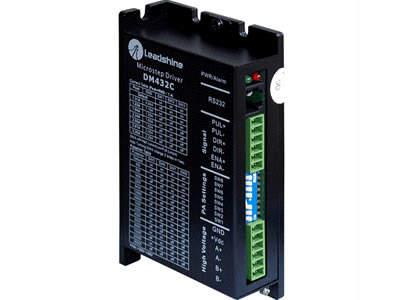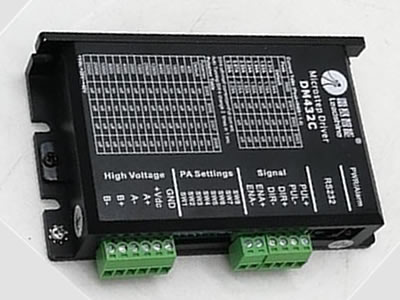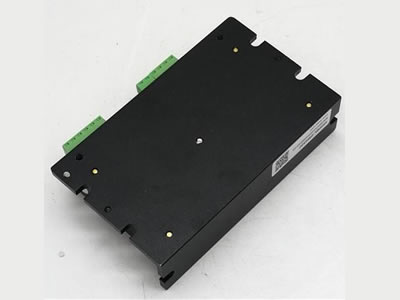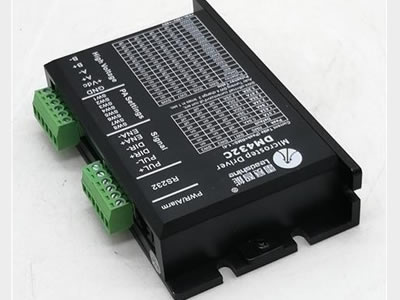
Leadshine DM432C Stepper Motor Driver
1.Extra-low motor noise offers excellent quietness
2.Anti-Resonance, provides optimum torque and nulls mid-range instability
3.upply voltage up to +40 VDC .
This Products is available in stock.
This Products is available in stock.
This Products is available in stock.
we will ship the package within 48 hours after the buyers pay momey by paypal
it is made in China Shenzhen Leadshine Technlogy Co.,Ltd ,100% original,
The Leadshine DM432C is a versatility fully digital stepping drive based on a DSP with advanced control algorithm. It brings a unique level of system smoothness, providing optimum torque and nulls mid-range instability. The Self-test and auto-configuration technology offers optimum responses with different motors and easy-to-use. The driven motors can run with much smaller noise, lower heating, smoother movement than most of the drives in the markets. Its unique features make the DM432C an ideal solution for applications that require low-speed smoothness.
Features:
Extra-low motor noise offers excellent quietness
Anti-Resonance, provides optimum torque and nulls mid-range instability
Self-test and Auto-configuration technology, offers optimum responses with different motors
Microstep resolutions programmable, from full-step to 102,400 steps/rev
Supply voltage up to +40 VDC
Output current programmable, from 0.5A to 3.2A
Pulse input frequency up to 200 KHz
Automatic idle-current reduction
Supports PUL/DIR and CW/CCW modes.
Electrical Specifications (Tj = 25oC/77oF)
Parameters |
DM432C |
|||
Min |
Typical |
Max |
Unit |
|
Output current |
0.1 |
- |
3.2 (2.3 RMS) |
A |
Supply voltage |
+20 |
- |
+40 |
VDC |
Logic signal current |
7 |
10 |
16 |
mA |
Pulse input frequency |
0 |
- |
200 |
kHz |
Isolation resistance |
500 |
|
|
Mohm |
Connector P1 Configurations
Pin Function |
Details |
PUL+ |
Pulse signal: In single pulse (pulse/direction) mode, this input represents pulse signal, each rising or falling edge active (software configurable); 4-5V when PUL-HIGH, 0-0.5V when PUL-LOW. In double pulse mode (pulse/pulse) , this input represents clockwise (CW) pulse,active both at high level and low level (software configurable). For reliable response, pulse width should be longer than 2.5µs. Series connect resistors for current-limiting when +12V or +24V used. The same as DIR and ENA signals. |
PUL- |
|
DIR+ |
DIR signal: In single-pulse mode, this signal has low/high voltage levels, representing two directions of motor rotation; in double-pulse mode (software configurable), this signal is counter-clock (CCW) pulse,active both at high level and low level (software configurable). For reliable motion response, DIR signal should be ahead of PUL signal by 5µs at least. 4-5V when DIR-HIGH, 0-0.5V when DIR-LOW. Please note that rotation direction is also related to motor-driver wiring match. Exchanging the connection of two wires for a coil to the driver will reverse motion direction. |
DIR- |
|
ENA+ |
Enable signal: This signal is used for enabling/disabling the driver. High level (NPN control signal, PNP and Differential control signals are on the contrary, namely Low level for enabling.) for enabling the driver and low level for disabling the driver. Usually left UNCONNECTED (ENABLED). |
ENA- |
Connector P2 Configurations
Pin Function |
Details |
+Vdc |
Power supply, 20~40 VDC, Including voltage fluctuation and EMF voltage. |
GND |
Power Ground. |
A+, A- |
Motor Phase A |
B+, B- |
Motor Phase B |
Microstep resolutions and output current are programmable, the former can be set from full-step to 102,400 steps/rev and the latter can be set from 0.1A to 3.2A.
However, when it's not in software configured mode, this driver uses an 8-bit DIP switch to set microstep resolution, and motor operating current, as shown below:

Microstep Resolution Selection
When it's not in software configured mode, microstep resolution is set by SW5, 6, 7, 8 of the DIP switch as shown in the following table:
Microstep |
Steps/rev. (for 1.8o motor) |
SW5 |
SW6 |
SW7 |
SW8 |
1 to 512 |
Default/Software configured |
on |
on |
on |
on |
2 |
400 |
off |
on |
on |
on |
4 |
800 |
on |
off |
on |
on |
8 |
1600 |
off |
off |
on |
on |
16 |
3200 |
on |
on |
off |
on |
32 |
6400 |
off |
on |
off |
on |
64 |
12800 |
on |
off |
off |
on |
128 |
25600 |
off |
off |
off |
on |
5 |
1000 |
on |
on |
on |
off |
10 |
2000 |
off |
on |
on |
off |
20 |
4000 |
on |
off |
on |
off |
25 |
5000 |
off |
off |
on |
off |
40 |
8000 |
on |
on |
off |
off |
50 |
10000 |
off |
on |
off |
off |
100 |
20000 |
on |
off |
off |
off |
125 |
25000 |
off |
off |
off |
off |
Current Settings
When it's not in software configured mode, the first three bits (SW1, 2, 3) of the DIP switch are used to set the dynamic current. Select a setting closest to your motor's required current.
Peak Current |
RMS Current |
SW1 |
SW2 |
SW3 |
Default/Software configured (0.1 to 3.2A) |
ON |
ON |
ON |
|
1.31A |
0.94A |
off |
on |
on |
1.63A |
1.16A |
on |
off |
on |
1.94A |
1.39A |
off |
off |
on |
2.24A |
1.60A |
on |
on |
off |
2.55A |
1.82A |
off |
on |
off |
2.87A |
2.05A |
on |
off |
off |
3.20A |
2.29A |
off |
off |
off |






